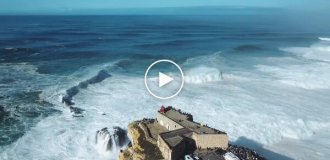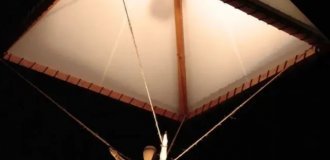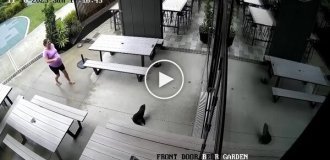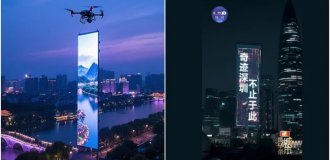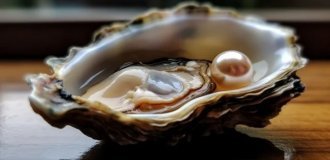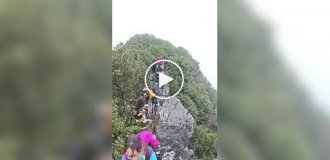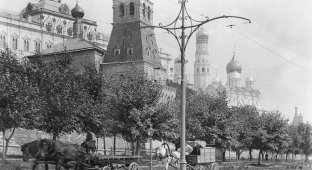Photos from the archives of A.S. Potresova (50-60 years) and A.L. and A.A.Zilovs (80s).
Garden Ring, 1957.
The photograph captures a piece of Sadovaya-Triumfalnaya from Mayakovsky Square towards Chekhov Street, today's Malaya Dmitrovka. Almost all the houses on both the right and left sides have been demolished due to the expansion of the Garden Ring. The photo was taken from the window of a building that has survived to this day, where some kind of agricultural organization, like “Sortsemovoshchi”, was located.

Fountain on Arbat Square, 1956.

Hotel "Ukraine", 1955, spring. This photo was taken from the side of Krasnopresnenskaya embankment and Krasnopresnensky Park, which stretched along the embankment of the Moskva River. Actually, there was no embankment itself as such yet - there was just a descent to the river, and they didn’t even think about the Hammer business center.

Shmitovsky proezd, 1955, spring.

Tverskoy Boulevard, 1956. This is the beginning of Tverskoy Boulevard, adjacent to Nikitsky Gate Square. The large house in the background exists, but the small one, hidden behind the trees, does not - the TASS building was built in its place. By the way, according to many architects, the huge combined window openings of the new building destroyed the rhythm of the space of Tverskoy Boulevard.

Bolshaya Molchanovka, courtyard of house No. 18, 1962

Bolshaya Molchanovka, house No. 8 (demolished), 1959.

Bolshoi Rzhevsky Lane, 1963.

Maly Rzhevsky Lane, 1959.

Bolshaya Molchanovka, near house No. 20 (demolished), 1957. Moscow, which does not exist. 50-80

Bolshoi Rzhevsky Lane

Malaya Molchanovka

Grille near the Central House of Writers. Bolshaya Nikitskaya, 53

Krasnaya Presnya, 1956

Dog Playground A small triangle in the area of Arbat and Bolshaya Molchanovka, called the Dog Playground, now remains to exist only in memories and old photographs. According to legend, a site arose on the site of the Psarny, or Dog, yard for the royal hunt, and has been known since the 17th century. In 1952, the Dog Playground became part of Kompozitorskaya Street, and in the 1960s. it was destroyed during the construction of New Arbat.

Dog Playground, spring 1961 One of the most stylish mansions in Dog Playground, with interesting architectural deviations. The portico of the building has a stepped shape, highly simplified columns are connected into an arch and do not have the usual completion in the form of an order. This mansion is famous for the fact that at the end of the 19th century, the mother of the future leader of the proletariat, Maria Aleksandrovna Ulyanova, lived there, and Vladimir Ilyich himself stayed here on the way to exile. There was even a memorial plaque on the house, which, however, did not save it from demolition.

Povarskaya, 52, Central House of Writers, 1960s.

Malaya Nikitskaya (formerly Kachalova street), 1961-1962. On the left you can see the fence behind which is the Church of the Great Ascension. The temple along with the bell tower was founded in 1799-1801. By 1812, the refectory and basement parts of the church were built. Construction was completed in 1848, but the bell tower was never erected. At the end of 2001, they decided to complete the bell tower, and therefore the fence was partially demolished.

Nikitsky Boulevard, 1959-1960 before the start of construction of the tunnel under Arbat Square

Corner of Krivonikolsky Lane, 1950s Before us is the House of Health Education, an example of the neoclassical era. It was demolished in 1962 during the construction of New Arbat. In the house on the right there was a shoe repair shop.

Krivonikolsky Lane, 1950s This is a rustic view almost in the very center of Moscow. Krivonikolsky Lane itself was knee-shaped and ran parallel to Serebryany Lane. The houses that can be seen in the distance are located on Arbat.
[img]https://cn1.nevsedoma.com.ua/images
/2009/5/1/02100002.jpg[/img]
Wall of the Andronikov Monastery on the Yauza, 1958-59.

Spassky Cathedral of the Spaso-Adronik Monastery, 1958-59.

Novospassky Monastery, general view, 1956-57.


Simonov Monastery, mid-1950s.

Borodinsky Bridge and the Ministry of Foreign Affairs building on Smolenskaya Embankment, day, 1957 The photograph was taken from the side of the Kievsky railway station with a view of the then brand new high-rise building on Smolenskaya Embankment, which houses the Ministry of Foreign Affairs of the Russian Federation. According to legend, Stalin personally painted the spire of this high-rise building. After this, spiers were added to all the high-rise buildings, made of metallized glass that sparkled in the sun.

Lenin Mountains, 1955

Smolenskaya embankment, 1955 On the other side of the Moscow River, on the Smolenskaya embankment, the house of the architect Nikolai Ivanovich Gaigarov is visible. To the left of it, between the Gaigarovsky house and the small mansion, Protochny Lane begins. The British Embassy can currently be seen to its left. And on the opposite side, where the photographer stood, in those days the embankment had not yet been built, and there was only a sandy beach.

Arbat Square (west side), 1969

Arbat, street view from house 38 towards Smolenskaya Square, 1966. The pedestrians are very interesting - like something out of a 60s movie.

Arbat, street view from house 23 towards Smolenskaya Square. The only trolleybus on this street, route 39, runs along Arbat, 1980.

View of Prechistenka from Chisty Lane, 1981

Gagarinsky Lane (then Ryleeva Street), 1967. View in the direction of the Garden Ring. Khrushchevsky Lane goes to the left. Opposite it is a now disappeared wooden house.

Plyushchikha Street, view towards the Garden Ring. 3rd Truzhenikov Lane (formerly 3rd Vozdvizhensky) goes to the left, 1980

Spasopeskovskaya Square, southeast corner, 1966. Here is a famous monument of the wooden Moscow Empire style - Shchepochkina's house, No. 6. It was dismantled in 1994 and now recreated using 15% of the previous log house. Ahead is a wooden house that has not been preserved (No. 4)

1st Truzhenikov Lane (formerly 1st Vozdvizhensky), before exiting to Plyushchikha, 1980.

Crystal Lane, 1969.

Staropasky Lane towards Bol. Cherkassky lane On the right in the foreground you can see a piece of the Church of St. Cosmas and Damian in Starye Paneh, 1980.

Varvarka (then Razin Street). The Rossiya Hotel is under construction, 1967

Ashcheulov Lane in 1980, view towards the street. Sretenki (building No. 9 on the right)

Bolshoi Sukharevsky Lane in 1980, view towards Trubnaya Street (on the left - building No. 6/8)

The last lane in 1980, view towards Sretenka. The houses on the left have been demolished, now in their place is the School of Dramatic Art.


